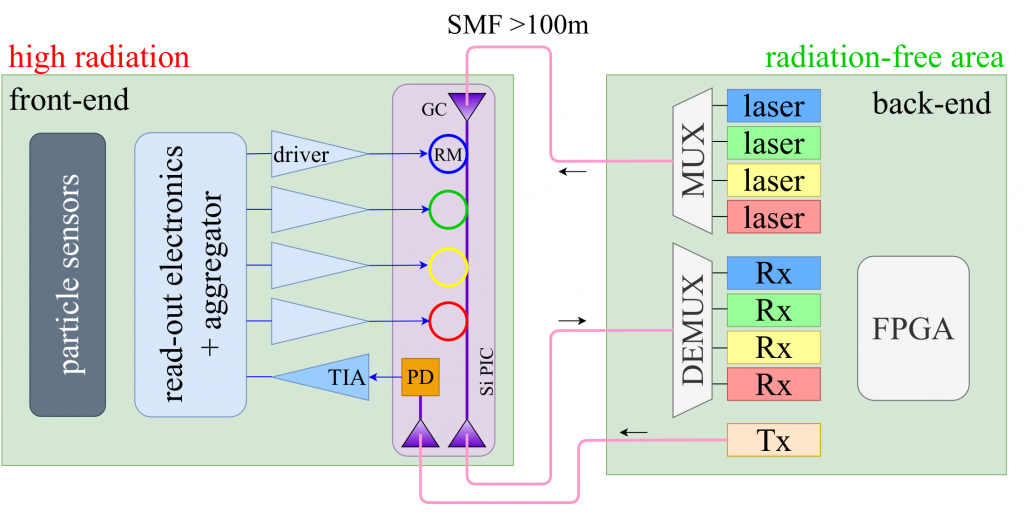PhD thesis defense to be held on April 24, 2024, at 13:00 (Conference Room, New ECE building)
 Picture Credit: Thenia Prousalidi
Picture Credit: Thenia Prousalidi
Thesis title: System Development of Silicon Photonics Transceivers for Future Upgrades of High Energy Physics Experiments at CERN
Abstract: In the coming years, various upgrades will take place in CERN's detectors and experiments. The first one of these, called the high luminosity LHC project, is already underway and foresees the starting of the operation of the upgraded systems in 2026. Starting at the end of the HL-LHC era, the high radiation levels and increased data rates due to the increased luminosity of the accelerator will impose the need for a new generation of optical links, able to withstand the extreme condition in the detectors, and support the data rates. The currently available optical transceivers will not be able to survive in the innermost regions of some of the detectors due to their limited radiation tolerance. It is therefore evident that a new generation of optical links will be required in future upgrades of experiments at CERN. SiPh has been identified as the perfect candidate for this upgrade, since it combines all the advantages that are required for such an application.
In recent years CERN has taken an interest in the SiPh technology for the aforementioned reason. An extensive effort has been taking place the past years within the EP-ESE group at CERN that focuses on the modelling and development of SiPh transceivers for HEP application. This effort includes the simulation, design and fabrication of SiPh PICs for the development of the necessary building blocks that can be combined to realize radiation-hard SiPh transceivers. At the same time, this effort includes the testing and characterization of the designed structures as part of the feedback process that is required to make design, technology and architecture choices regarding the target system. An indispensable side of the development of radiation-hard SiPh based links is also the extensive study and validation of the radiation tolerance of the developed components and circuits. Without this study, the integration of SiPh based TRx is CERN experiments will not be possible.
Within the CERN collaboration, various SiPh test chips have been designed and characterized. Relevant to the work described in this thesis is the second chip that was designed at CERN in 2019 and was fabricated by imec's multi project wafer (MPW) in 2020, namely PICv2. This test chip includes IP blocks designed at CERN or made available by the foundry's libraries, combined to form structures for data transmission demonstrations. More specifically, the PIC includes various versions of RMs, Mach-Zehnder modulators (MZMs), Ge PDs, optical multiplexers, interferometers for polarization recovery studies, as well as a WDM circuit with four cascaded RMs connected in series.
This PIC serves first of all as a test vehicle for the characterization of the individual components, the implementation of radiation tests and the comparison of the different versions of the components in terms of performance and radiation hardness. At the same time, the building blocks that are available from the PIC can be combined and utilized for the assembly of a first version of transmitters and receivers, allowing higher level testing and characterization.
On a system level, the development and operation of SiPh based transceivers involves many challenges. On the transmitter side, a very important challenge is the wavelength stabilization of the RMs. This is necessary to achieve their stable operation at the desired wavelength of operation irrespective of variations in the environmental conditions (e.g. temperature, external laser wavelength variation). Another important challenge is the polarization management. This is required due to the unique architecture of such a link that imposes the placement of the optical sources in the back-end, away for the SiPh PICs, and their connection with SMFs that do not maintain the polarization. The same problem exists also on the receiver side, since the SiPh Rx will be connected to the BE Tx through long SMFs. Especially in the case of a WDM implementation, the architecture of the whole link, including the SiPh circuit, the power supplies and the polarization management and thermal tuning, becomes more complex and requires extra effort and problems to be addressed.
The scope of this thesis, that also reflects the work that the writer carried out during the past three years, evolves around the development of a SiPh Tx and Rx based on the components provided by PICv2. It also concerns the addressing of the challenges that are involved in the development of such a SiPh TRx, from a system point of view. The aforementioned objectives target the advancing towards a first demonstration of SiPh TRx for HEP experiments.
Supervisor: Professor Hercules Avramopoulos
PhD Student: Thenia Prousalidi
